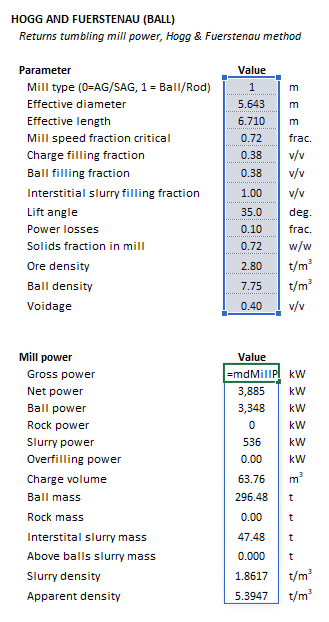Revision as of 11:12, 4 December 2024 by imported>Scott.Munro
Description
This article describes the Hogg and Fuerstenau (1972) method for estimating the power draw of a tumbling mill.[1]
Model theory
 This content is available to registered users. Please log in to view. This content is available to registered users. Please log in to view.
|
Excel
The Hogg and Fuerstenau mill power model may be invoked from the Excel formula bar with the following function call:
=mdMillPower_HoggFuerstenau(Parameters as Range)
Invoking the function with no arguments will print Help text associated with the model, including a link to this page.
The Parameters array and model results are defined below in matrix notation, along with an example image showing the selection of the same arrays in the Excel interface:
Please note the Excel function expects the mill diameter ( ) and length (
) and length ( ) values in units of meters, which are internally converted to feet for use in the power equation presented above.
) values in units of meters, which are internally converted to feet for use in the power equation presented above.
SysCAD
The Hogg and Fuerstenau power model is an optional calculation for tumbling mill units. If selected, the input and display parameters below are shown.
| Tag (Long/Short)
|
Input / Display
|
Description/Calculated Variables/Options
|
| HoggFuerstenau
|
| HelpLink
|

|
Opens a link to this page using the system default web browser. Note: Internet access is required.
|
| MillType
|
AG/SAG or Ball/Rod
|
Type of mill, AG/SAG (RockMass, no AboveBallsSLMass) or Ball (AboveBallsSLMass, no RockMass).
|
| MillDiameter
|
Input/Display
|
Diameter of the mill (inside liners).
|
| MillLength
|
Input/Display
|
Length of the mill (inside liners).
|
| FracCS
|
Input/Display
|
Fraction critical speed of the mill.
|
| ChargeFilling
|
Input/Display
|
Volumetric fraction of the mill filled with charge, including balls and interstitial voids between balls.
|
| BallFilling
|
Input/Display
|
Volumetric fraction of the mill filled with balls, including slurry and interstitial voids between balls.
|
| InterstialSLFill
|
Input/Display
|
Volumetric fraction of the interstitial charge void space occupied by slurry.
|
| LiftAngle
|
Input
|
Lift angle of the charge.
|
| PowerLosses
|
Input
|
Fraction of power lost due to mill drive efficiency ( ). ).
|
| SolidsFraction
|
Display
|
Mass fraction of solids in the slurry phase.
|
| OreDensity
|
Display
|
Density of solids.
|
| BallDensity
|
Input/Display
|
Density of balls.
|
| Voidage
|
Input/Display
|
Volumetric fraction of interstitial void space in the charge
|
| ChargeVolume
|
Display
|
Volume of charge in the mill.
|
| BallMass
|
Display
|
Mass of balls in the mill.
|
| RockMass
|
Display
|
Mass of coarse rocks in the mill (AG/SAG only).
|
| InterstitialSLMass
|
Display
|
Mass of slurry occupying charge void space.
|
| AboveBallsSLMass
|
Display
|
Mass of excess slurry resident outside/above charge (Ball mill only).
|
| RhoSlurry
|
Display
|
Density of slurry phase.
|
| ApparentDensity
|
Display
|
Density of total charge (including balls, rock, slurry and voids).
|
| BallsPower
|
Display
|
Power drawn by the ball component of the mill load.
|
| RocksPower
|
Display
|
Power drawn by the rock component of the mill load.
|
| SlurryPower
|
Display
|
Power drawn by the interstitial slurry component of the mill load.
|
| OverfillingPower
|
Display
|
Power drawn by the overfilling, or excess, slurry component of the mill load (when the interstitial voids are completely filled with slurry).
|
| NetPower
|
Display
|
Net power drawn by the mill (excluding drive inefficiencies).
|
| GrossPower
|
Display
|
Gross power drawn by the mill (including drive inefficiencies).
|
See also
References
- ↑ Hogg, R., 1972. Power relationships for tumbling mills. AIME Trans., 252, pp.418-423.










